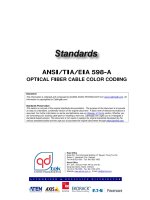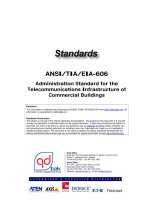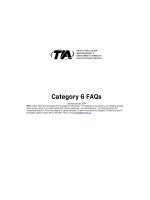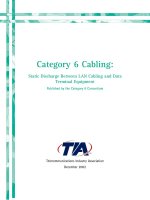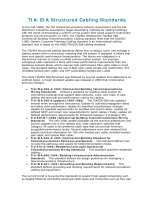Tài liệu Cabling Standard - (Private) - State of Virginia - IT Resource Management Standard ppt
Bạn đang xem bản rút gọn của tài liệu. Xem và tải ngay bản đầy đủ của tài liệu tại đây (315.05 KB, 17 trang )
COV ITRM Standard NET2001-01.1
Date: December 7, 2001
Revision: 0
COMMONWEALTH OF VIRGINIA
Information Technology Resource Management Standard
NETWORKING, TELECOMMUNICATIONS, AND
CABLING STANDARD
Department of Technology Planning
Networking, Telecommunications and COV ITRM Standard NET2001-01.1
Cabling Standard Date: December 7, 2001
Revision: 0
Preface
Publication Designation
COV ITRM Standard NET2001-01.1
Subject
Networking, Telecommunications, and Cabling
Effective Date:
December 7, 2001
Supersedes
COV ITRM Standard 96-1, Telecommunications
Cabling, dated January 26, 1996
Scheduled DTP Review
One (1) year from effective date
Authority
Code of Virginia, § 2.2-226
(Powers and Duties of the Secretary of
Technology)
Code of Virginia, § 2.2-2651
(Powers and Duties of the Council on
Technology Services)
Code of Virginia, § 2.2-1701
(Powers and Duties of the Department of
Technology Planning)
Code of Virginia, §2.2-1303
(Powers and Duties of the Department of
Information Technology)
Scope
This standard is applicable to all state agencies
and institutions of higher education (hereinafter
collectively referred to as "agencies") that are
responsible for local and wide-area networking,
telecommunications, or related cabling between
or within state-owned or state-leased buildings.
This standard is offered as guidance-only to local
government entities.
Purpose
Effective telecommunications and networking
cannot be accomplished without adherence to
standards. Infrastructure costs cannot be
contained without adherence to sound installation
and management practices. To ensure that future
communications and connectivity needs of
agencies are met in a cost-effective manner, this
document confirms the Commonwealth of
Virginia’s support for ANSI TIA/EIA and IEEE
(Institute of Electrical and Electronics Engineers)
standards for telecommunications and delineates
required practices. The Telecommunications
Industry Association (TIA) develops standards
for cables. The Electronics Industry Association
(EIA) focuses on physical device standards such
as RS232D. ANSI is the American National
Standards Institute. This group approves
standards as having been properly developed.
Objectives
To explain the interplay of industry-supported
standards, Virginia laws, Governor’s Executive
Orders, and sound enterprise business practices in
providing an architectural foundation for
telecommunications and networking in Virginia’s
agencies.
To provide agency requirements related to
networking and telecommunications
infrastructure development, maintenance and
administration.
To provide agency requirements related to local
and wide area network services provision.
General Responsibilities
In accordance with the Code of Virginia, the
following provisions apply:
Secretary of Technology
Responsible for:
• Directing the formulation and promulgation
of policies, standards, specifications, and
guidelines for information technology in the
Commonwealth, including, but not limited
to, those (i) required to support state and
local government exchange, acquisition,
storage, use, sharing, and distribution of
geographic or base map data and related
technologies and (ii) concerning the
development of electronic transactions
including the use of electronic signatures as
provided in § 59.1-496
.
• Directing the establishment of statewide
standards for the efficient exchange of
electronic information and technology,
ii
Networking, Telecommunications and COV ITRM Standard NET2001-01.1
Cabling Standard Date: December 7, 2001
Revision: 0
including infrastructure, between the public
and private sectors in the Commonwealth.
Council on Technology Services (COTS)
Responsible for :
• Advising and assisting the Secretary of
Technology in exercising the powers and
performing the duties conferred.
Department of Technology Planning (DTP)
Responsible for:
• Assisting the Secretary of Technology in the
development of statewide policies affecting
technology at all levels of government, in
the business sector, and among the general
citizenry.
• Developing and promulgating policies,
standards, and guidelines for managing
information technology in the
Commonwealth.
• Developing statewide standards for the
efficient exchange of electronic information
and technology, including infrastructure,
between the public and private sectors in the
Commonwealth.
Department of Information Technology (DIT)
The Department shall have the following powers
and duties concerning the planning, budgeting,
acquiring, using and disposing of
communications equipment and services:
• To formulate specifications for
telecommunications, automated data and
word processing, and management
information systems.
• To analyze and approve all procurements of
interconnective telecommunications
facilities, telephones, automated data and
word processing, and other communications
equipment and goods.
• To review and approve all agreements and
contracts for communications services prior
to execution between a state agency and
another public or private agency.
• To develop and administer a system to
monitor and evaluate executed contracts and
billing and collection systems.
• To exempt from review requirements, but
not from the state's competitive procurement
process, any state agency which establishes,
to the satisfaction of the Department, (i) its
ability and willingness to administer
efficiently and effectively the procurement
of communications services or (ii) that it has
been subjected to another review process
coordinated through or approved by the
Department.
All State Agencies
Responsible for:
• Cooperating with the Secretary of
Technology, the Department of Information
Technology, and the Department of
Technology Planning in the performance of
their powers and duties; and
• Complying with the Department of
Technology Planning’s policies, standards,
and guidelines for information technology
resources in the Commonwealth.
Definitions
Networking means any local, wide-area,
metropolitan-area or campus network established
for use by agencies of the Commonwealth.
Telecommunications means any transmission,
emission, or reception of signs, signals, writings,
images, and sounds, or information of any nature
by wire, radio, visual, optical, or other
electromagnetic systems.
Cabling means physical transmission medium
and related equipment including wire, optical, or
other physical cable that supports the physical
network layer.
Related COV ITRM Policies, Standards, and
Guidelines
COV ITRM Policy NET2001-01.1, Networking
and Telecommunications
COV ITRM Guideline NET2001-01.1,
Networking, Telecommunications, and Cabling
iii
Networking, Telecommunications and COV ITRM Standard NET2001-01.1
Cabling Standard Date: December 7, 2001
Revision: 0
Table of Contents
Background 1
Approach 1
Reviews 1
Statement of ITRM Requirements for Networking, Telecommunications and Cabling 1
Physical Network Layer Requirements (Cabling) 1
Data Link Layer Requirements (Media Access and Data Link) 5
Network and Transport Layer Standards (network addressing protocols and transport
protocols) 5
Network Related Requirements Involving “Application Layers” (Session, Presentation,
and Application Layers) 6
Other Related Administrative Procedures 6
Resources 6
Requesting Waivers to Requirements 9
Glossary 11
Appendix A: Waiver 12
Appendix B: Assignment of Uniform Alphanumeric Publication Designations for all
Policies, Standards, and Guidelines 13
iv
Networking, Telecommunications and COV ITRM Standard NET2001-01.1
Cabling Standard Date: December 7, 2001
Revision: 0
Background
Earlier Commonwealth telecommunications standards and guidelines focused on building
wiring. The COV ITRM Standard NET2001-1.1 addresses expanded requirements in all
areas of networking and telecommunications. These expanded requirements emanated
from the work of the Enterprise Architecture Network Domain team. This team had state
agency, local government, and higher education members.
Approach
This document will provide: 1) a listing of the telecommunications, networking, cabling
and administration requirements adopted by the Commonwealth; 2) reference materials
and Web sites related to the requirements; and 3) a general discussion of how state
agencies would typically address the requirements. ANSI TIA/EIA standards and IEEE
standards referenced herein are adopted in both their present state and as amended or
replaced unless otherwise indicated in the statement of Information Technology Resource
Management (ITRM) requirements provided below. Every effort will be made to ensure
that these requirements are reviewed annually. Whenever TIA/EIA or IEEE introduce
major modifications, this will trigger a midyear review of requirements by the
Department of Technology Planning. As reviews are conducted, the review dates and
recommended modifications will be added to this document.
Reviews
Revisions are anticipated within six months of the release date to accommodate the
adoption of Category 6 cabling standards by TIA/EIA. Also, towards the end of 2001,
TIA/EIA is expected to release new cable administration standards. A full review of the
COV ITRM Standard NET 2001-1.1 is anticipated within one year of the release date.
Statement of ITRM Requirements for Networking, Telecommunications
and Cabling
The following ITRM requirements for state agencies address various aspects of providing
and managing the infrastructure needed to ensure effective voice, data, and video
telecommunications services in the Commonwealth. This infrastructure is a critical
resource needed to conduct the business of the Commonwealth. Requirements are
discussed using the telecommunications and networking reference layers of the Open
Systems Interconnect Seven Layer Model, also called the OSI model and the TCP/IP
stack layers.
Physical Network Layer Requirements (Cabling)
The physical network layer addresses signal transmission media, connectors, and related
devices. The Commonwealth of Virginia bases its physical layer cabling standards on the
1
Networking, Telecommunications and COV ITRM Standard NET2001-01.1
Cabling Standard Date: December 7, 2001
Revision: 0
2000 and 2001 releases of TIA/EIA 568-B.1, B.2, and B.3 (i.e., the second release of
ETIA/EIA 568 divided into parts 1, 2, and 3).
1
Requirement 1) Agencies must install standards-based structured cabling systems for
telecommunications. Agencies must employ standards-based designs, topologies,
components, distances, installation methods, cable testing, and cable administration
whether for cabling in new construction, for cabling plant additions or modifications, or
for building renovations and additions. Also, agencies must require standards-based
infrastructure installations in leased space. All minimum requirements or mandatory
criteria addressed in TIA/EIA 568-B.1, 2 and 3 must be met unless exceptions are noted
in this document.
The three TIA/EIA standards are discussed in more detail below:
• TIA/EIA-568-B.1, Commercial Building Telecommunications Cabling Standard,
Part 1: General Requirements. This TIA/EIA standard addresses cabling
infrastructure design, installation and field testing for horizontal cabling,
backbone cabling, and work areas. It also covers requirements for
telecommunications rooms, equipment rooms, and entrance facilities. The
TIA/EIA standard is used in conjunction with local electrical codes and standards
to provide an appropriate cabling plant.
• TIA/EIA-568-B.2, Commercial Building Telecommunications Cabling Standard,
Part 2: Balanced Twisted Pair Cabling Components, addresses specifications for
horizontal 4-pair cables and backbone multi-pair cables and components. Both
Category 5e and Category 3 cable specifications and laboratory testing are
addressed. Field tester specifications and additional field testing requirements are
incorporated into this document.
• TIA/EIA-568-B.3, Commercial Building Telecommunications Cabling Standard,
Part 3: Optical Fiber Cabling Components Standard, addresses multi-mode
(50/125 µm and 62.5/125 µm ) and single-mode fiber optic cabling components,
transmission standards, and field testers.
The Commonwealth of Virginia requires one major modification to the TIA/EIA cabling
standards. In the TIA/EIA standards, category 3 cable is permitted (see EIA/TIA 568-
B.1). However, Virginia does not permit new installations of Category 3 horizontal cable
without a waiver. For new installations, Virginia allows only tested, category 5e cabling
and parts. Using category 5e horizontal cable as a base standard will enable a consistent
1
These standards are also called TIA/EIA 568-1, 568-2, and 568-3. These standards are not to be confused
with T568A and T568B, which address eight position jack pin pair assignments and appear as Figures 1
and 2 in the revised TIA/EIA-568-B.2. TIA/EIA 568-B standards supersede the following: EIA/TIA 568-
A, 568-A Addenda 568 A-1 through 568 A-5, TSB67, TSB72, TSB75, TSB95, and TIA/EIA/IS729.
2
Networking, Telecommunications and COV ITRM Standard NET2001-01.1
Cabling Standard Date: December 7, 2001
Revision: 0
upward migration path for agencies, ensure high bandwidth transmission capabilities over
copper, and provide progress towards viable gigabit connections to meet future needs.
2
Requirement 2) Agencies are to provide a minimum of certified Category 5e cable
when installing new or replacement telecommunications cabling. In a typical office, two
or more outlets would be provided with the first outlet having a Category 5e connection
and the second, Category 5e or fiber.
Categories 6 and higher cabling practices are not recognized by the Commonwealth at
this time. These cabling options will receive additional consideration by the
Commonwealth when TIA/EIA standards have been adopted and when cost effective
vendor solutions have been provided. Agencies that have installed a version of category
6 cabling prior to the promulgation of NET 2001-01.1 standard are to notify DTP of the
scope of their installation and the vendors used if the installation is not fully backwards
compatible with category 5e cabling and fully compliant with category 5e performance
tests.
Regarding eight position jack pin/pair assignments, Virginia chose to adopt the T568A
standard in its 1996 publication of cabling standards for the Commonwealth. T568A is
the pin/pair standard followed by the federal government and recommended by TIA/EIA.
The T568B standard is widely used by commercial enterprises and in education. T568B
is only called for by the standards “if necessary to accommodate certain 8-pin cabling
systems”. Virginia agencies are cautioned to be aware of this difference and to continue
the pin/pair assignment that is in place within their facilities. If using the T568B
standard, agencies should apply for a waiver. (See Appendix A.)
Requirement 3) Virginia agencies are required to implement the eight-position jack
pin/pair assignment designated as T568A.
EIA/TIA 568-B also addresses fiber optic cabling. The revised TIA/EIA-568-B.3
standard adds the 50/125 micron fiber type, permits all connector types that are designed
to organize and manage the fiber in pairs and that are the subject of a FOCIS document
3
,
incorporates performance standards for connectors, and specifies connecting hardware
requirements. The changes follow de facto standards. Virginia standards do not
presently address fiber.
The cabling requirements noted above are not intended to hasten the replacement of
existing cabling plants that do not meet referenced standards. Agency business
requirements should drive replacement decisions. Requirements are also not intended to
2
Category 6 cabling standards are presently anticipated by the end of 2001. The Category 6 standard has
been referenced both as TIA/EIA 854 and as addendum TIA/EIA 568-B1.1. Category 7 standards are
expected in late 2001 also. Presently, complete standards are available only for Category 5e. Currently
available Category 6 implementations are based on proprietary protocols. The costs and benefits of
Category 6 versus Category 5e cannot be determined at this time. The costs of fiber are decreasing rapidly.
3
FOCIS means Fiber Optic Connector Intermateability Standard.
3
Networking, Telecommunications and COV ITRM Standard NET2001-01.1
Cabling Standard Date: December 7, 2001
Revision: 0
thwart research in telecommunications and distance learning by institutions of higher
education.
Also related to the physical layer is the TIA/EIA standard that specifies requirements for
pathways and spaces traversed by telecommunications cabling. TIA/EIA 569-A-1998,
Commercial Building Telecommunications Pathways and Spaces, provides requirements
geared to the average office situation. This information is to be used by state agencies for
the design and implementation of appropriate telecommunications system pathways and
telecommunications rooms for both state owned facilities and leased space. TIA/EIA
569-A deals with floor, ceiling, and perimeter pathways, conduit, pull boxes, tray sizes,
closet sizes, and other aspects of routing cable throughout and between buildings. Areas
discussed in this TIA/EIA standard include work areas, horizontal pathways, backbone
pathways, wiring closets, equipment rooms, and entrance facilities. Specifications ensure
that proper pathways and minimum space requirements support cable protection and
cable maintenance activities.
Requirement 4) Virginia agencies are expected to provide appropriate pathways and
spaces for telecommunications cabling and equipment by implementing the
recommended minimum requirements in standard TIA/EIA 569-A, Commercial Building
Telecommunications Pathways and Spaces, and all related addenda for state offices that
have an average office density (one office per 100 square feet). Pathway and room size
requirements must be adjusted for higher and lower densities of telecommunications
outlets or equipment than is expected in the average situation.
Virginia agencies are required to meet more stringent floor loading specifications than
those provided in TIA/EIA 569-A. The following is substituted for TIA/EIA 569-A floor
loading requirements:
Requirement 5) Floor loading capacity in the equipment room shall be sufficient to
bear both the distributed and concentrated load of the installed equipment. The capacity
for distributed loading shall be greater than 1220 kilograms per square meter (813 pounds
per square foot). The capacity for a concentrated load shall be greater than 450 kilograms
per square meter (300 pounds per square foot).
The final physical layer requirement for Virginia agencies deals with grounding and
bonding. Again, Virginia agencies are to follow TIA/EIA standards.
Requirement 6) All Virginia agencies must follow grounding and bonding
requirements specified in TIA/EIA 607-1994, Commercial Building Grounding and
Bonding Requirements for Telecommunications.
TIA/EIA 607 provides grounding and bonding specifications for telecommunications
circuits and equipment. A ground provides conduction from each circuit or piece of
equipment to the earth. Proper grounding reduces shocks and damage to equipment.
Bonding refers to the connections between or bridging of two parts of a ground.
4
Networking, Telecommunications and COV ITRM Standard NET2001-01.1
Cabling Standard Date: December 7, 2001
Revision: 0
Note: TIA/EIA physical layer standards are generally used in conjunction with local
building code.
Data Link Layer Requirements (Media Access and Data Link)
The data link layer deals with the methods used to access the physical media. Most
agencies use some combination of Ethernet and switched Ethernet to access their media
to transmit data and perhaps voice or video over their telecommunications networks. A
small number of agencies use token ring methods. The standards that address Ethernet
and Token Ring are the IEEE 802 series of standards
4
. Virginia requires that agencies
standardize on access methods.
Requirement 7) Agencies changing their LAN services must migrate to a minimum
Virginia standard of IEEE 802.3 Fast Ethernet (100 Mbps Switched Ethernet) or to a
higher bandwidth Ethernet service (802.3 Full duplex Fast Ethernet, 802.3ab Gigabit
Ethernet over copper, Fast EtherChannel (a transitional proprietary Cisco solution
providing up to 400Mbps of service), or 802.3z Gigabit Ethernet over fiber).
What is required of agencies is the use of an access method within the above specified
migration path depending on their particular bandwidth needs. Agencies are not required
to know the details in the IEEE 802.3 standard.
Requirement 8) Agencies acquiring new Data Link Layer (e.g., Layer 2) switches must
ensure that the switches are manageable with SNMP
5
.
Network and Transport Layer Standards (network addressing protocols and
transport protocols)
OSI layers 3 and 4 are the network and transport layers. These layers are required to
connect to the outside world (e.g., beyond the LAN or metropolitan area network). The
network layer is involved with the address of the outside computer, and the transport
layer is involved with setting up the type of connection requested. Virginia requirements
specify that the protocols to be used by agencies for addressing and transporting must be
IP and TCP/UDP (i.e., the middle layers of the TCP/IP protocol stack).
Requirement 9) All agencies must ensure that each agency local area network (LAN)
node and LAN segment may be accessed using IP addressing no later than December of
2003. Agencies that do not currently provide IP addressing must develop plans to ensure
this accessibility.
Requirement 10) Agencies must employ TCP/IP as standard transport and addressing
protocols for all routed transmissions. Agencies establishing new and replacement
4
IEEE 802 standards may be downloaded free of charge at:
Knowledge of these standards is not required of agencies. These standards define how the access methods
works. Click terms and conditions at the aforementioned site to begin the download process.
5
SNMP is Simple Network Management Protocol. See Requirement 12.
5
Networking, Telecommunications and COV ITRM Standard NET2001-01.1
Cabling Standard Date: December 7, 2001
Revision: 0
connections to external business partners, local governments, and state agencies must
employ TCP/IP. If other protocols are used as a transitional strategy, when routed, these
protocols must be tunneled through TCP/IP.
Network Related Requirements Involving “Application Layers” (Session,
Presentation, and Application Layers)
Management and administration of telecommunications infrastructure is a critical part of
providing telecommunications services. Both ANSI TIA/EIA and the TCP/IP protocol
stack come into play in addressing administration standards.
Requirement 11) All agencies must employ Simple Network Management Protocol
(SNMP) compliant device management. SNMP is a protocol that enables management
information for a network element such as a switch to be inspected by a remote user.
SNMP is defined by RFC 1157
6
. SNMP provides a set of rules for automated device
management. Many vendors provided administration tools that use these methods and
protocols. The device must also be able to communicate with the tools. SNMP is
generally considered to be in the TCP/IP protocol suite.
Other Related Administrative Procedures
TIA/EIA 606 addresses the labeling of the cabling infrastructure using a uniform
administration scheme that can be adopted by vendors. This enables the scheme to
remain constant even though the user may change vendors, cable installation contractors,
or cable management personnel. The standard addresses such requirements as cable
labels must be legible, labels must be attached at appropriate points, splices, and
intervals, labels must be well attached, and labels must be protected from the
environment.
Requirement 12) All agencies must employ methods for administering
telecommunications infrastructure that are compliant with ANSI TIA/EIA 606-1993,
Administration Standard for the Telecommunications Infrastructure of Commercial
Buildings.
Resources
Virginia agency personnel involved in IT procurement, facilities management, or IT
administration may wish to acquire ANSI standard documentation. These documents
may be purchased from Global Engineering Documents. Often, several related standards
are available as a topic set (e.g., the cabling set). Website and other contact information
for Global Engineering are provided below:
6
RFC 1157 may be read at This memo defines a
simple protocol by which management information for a network element may be inspected or altered by
logically remote users.
6
Networking, Telecommunications and COV ITRM Standard NET2001-01.1
Cabling Standard Date: December 7, 2001
Revision: 0
Global Engineering Documents:
15 Inverness Way East
Englewood, CO 80112
800-854-7179 or 303-397-7956.
IEEE 802 standards are available for free download and may be obtained at the following
link: />.
Information available from vendors may be of considerable use to those agencies that are
involved in telecommunications infrastructure upgrades, new systems, or replacement
systems. Those who are implementing standards for an agency may wish to examine
white papers, RFP specifications, update news, and interpretations available from the
following sites. Also, many vendors whose products implement standards are interested
in sharing standards-related information with their customers.
BICSI
7
telecommunications association at provides resources
including current topic presentations, standards updates, and manuals (e.g.,
Telecommunications Distribution Methods Manual (TDMM)). The TDMM
manual is a how to guide for designers and installer that interprets the TIA/EIA
standards. BICSI was previously the Building Industry Consulting Services,
International. BICSI also provides RCDD
8
certification to designers and
installers.
CableTesting.Com at offers a wealth of free
information about cabling standards.
The National Electrical Contractors Association at
provides NECA/FOA 301-1997 - Standard for Installing and Testing Fiber Optic
Cables and other useful information.
Note: Please note that Virginia telecommunications infrastructure requirements no longer
reference the now rescinded federal government FIPS PUB modifications of ANSI
TIA/EIA standards. Information regarding the rescinding of related FIPS standards may
be found at />. Also, please note that most
agencies will implement the referenced ANSI and IEEE standards by acquiring products,
services, administration tools and protocol stacks that implement the standards. Very few
IT managers have detailed knowledge of the actual standards. Those state agency
7
BICSI is a non-profit telecommunications trade association, originally US-based but
now also with an office in Colchester, UK. The association covers data, voice and
video cabling. It aims to manage the quality and reliability of design and cabling
away from network equipment vendors and put it with the installers.
8
RCDD is Registered Communications and Distribution Designer, issued by BICSI.
7
Networking, Telecommunications and COV ITRM Standard NET2001-01.1
Cabling Standard Date: December 7, 2001
Revision: 0
individuals wishing to view rather than purchase the standards may do so by visiting the
Department of Technology Planning in the Richmond Plaza Building at 110 South 7
th
Street, Richmond, VA.
The following is a brief description of old and current telecommunications standards and
sets.
Current Standards
ANSI TIA/EIA-568-Set (06-2001) is composed of three parts.
TIA/EIA 568-B.1, Commercial Building Telecommunications Cabling Standard - Part 1
General Requirements, is a major new standard release that replaces the all of the
following standards and bulletins:
TSB67, TSB72, TSB75, TSB95, TIA568A, TIA568A addendum's 1,2,3,4, and
5, and TIA ScTP (PN-3193 Interim standard).
Key additions include Category 5e performance levels, 50/125µm fiber and allowance for
alternate fiber connectors other than the SC. This standard, which was released in 2001,
eliminates support for Category 5 in horizontal cabling. Category 5e becomes the
minimum accepted performance level for data transmission. Category 3 remains in the
standard for a second phone only jack in an office but is not acceptable for new cabling in
Virginia offices.
TIA/EIA 568-B.2, Commercial Building Telecommunications Cabling Standard - Part 2,
Balanced Twisted-Pair Cabling Components. This section provides technical content and
component requirements for 100 ohm twisted-pair cabling that is referenced by TIA/EIA
568-B.1. This information was covered previously in TIA/EIA 568-A, and addendum A-
5.
TIA/EIA 568-B.3, Commercial Building Telecommunication Cabling Standard - Part 3,
Optical Fiber Cabling Components Standard. This section provides technical content on
optical fiber cabling that is referenced by TIA 568-B.1. This information was covered
previously in TIA/EIA 568-A.
ANSI/TIA/EIA-569A-1998, Commercial Building Telecommunications Pathways and Spaces,
specifies minimum requirements for telecommunications pathways and spaces within a State
office building and between office buildings in a campus environment. Standards are given for
rooms, areas and pathways into and through which telecommunications equipment and media are
to be installed.
ANSI/TIA/EIA-570-1991, Residential and Light Commercial Telecommunications Wiring
Standard, gives an overview of premises wiring requirements for residential and light commercial
installations that are lesser requirements than the Virginia minimum requirement of Category 5e.
Basically, TIA/EIA 570 requires quality Category 3 premises wiring for voice connections. In
today’s Internet environment, there are very few instances where TIA/EIA 570 standards would be
appropriate for new or replacement wiring in state office buildings or education facilities.
ANSI/TIA/EIA-606-1993, Administration Standard for the Telecommunications Infrastructure of
Commercial Buildings, addresses the labeling and administration of the cabling infrastructure.
8
Networking, Telecommunications and COV ITRM Standard NET2001-01.1
Cabling Standard Date: December 7, 2001
Revision: 0
Labels must be legible, attached at appropriate points, splices, and intervals, well attached, and
protected from the environment.
ANSI/TIA/EIA-607-1994, Commercial Building Grounding and Bonding Requirements for
Telecommunications. This standard addresses how telecommunications cabling and equipment
should be grounded and how bonds between ground conductor components should be made.
T568A/T568B, reference the two RJ45 pin assignment specifications that form part of 568-A and
568-B. When four-pair cable is terminated to a connector (jack or plug), there are eight color-
coded wires (four twisted pairs). The standards define two different pin/pair assignment
combinations. They are called T568A and T568B (not to be confused with TIA/EIA 568-A and
TIA/EIA 568-B). The main difference between the two standards is the juxtaposition of the
orange and green pairs. A cable that is wired T568A at one end and T568B at the other end will
not work. Most commercial and school installations are going with the pin/pair assignment
designated T568B.
Old Standards
ANSI/TIA/EIA-568-A-1995, Commercial Building Telecommunications Cabling Standard, has now been replaced
by TIA/EIA-568-B.1, B.2, and B.3. TIA/EIA 568 A along with its numerous addenda has been incorporated into
the TIA/EIA 568-B Wiring Set.
TSB 67 - Technical Service Bulletin (TSB), which was originally amended to incorporate the
TIA/EIA 568A specifications for Category 5 testing procedures and minimum test result values.
This standard provided for four cable parameters to be tested: Length, Wire Map (Pin Out),
Attenuation, and Near End Cross Talk (NEXT). Cables or infrastructure which is to be considered
‘Category 5’ or ‘Category 5 Compliant’ must adhere to these specifications. Category 5e
specifications include more tests, which are delineated in TIA/EIA-568B.1 and B.2.
Requesting Waivers to Requirements
Under certain circumstances, waivers from the provisions of this standard may be granted
to state building owners or state agencies that lease space in non-state owned buildings if
compliance with the provisions of this standard would:
• adversely affect the accomplishment of an agency’s mission of an operator of a
State computer system or telecommunications system;
• cause a major adverse financial impact on an agency which is not offset by
Government wide savings; or
• cause damage to an existing building that has been identified and classified by a
federal, state or local government authority as an historic building.
9
Networking, Telecommunications and COV ITRM Standard NET2001-01.1
Cabling Standard Date: December 7, 2001
Revision: 0
Written waiver requests shall be submitted to:
Director
Department of Technology Planning
Richmond Plaza, 110 S. 7
th
Street
Richmond, VA 23219
The Departments of General Services, Information Technology, or Historic Resources
shall provide information and technical expertise to assist the Director in making
decisions on waiver requests.
State agencies shall not procure telecommunications related equipment and/or services
that do not meet all the provisions of this standard until a written waiver has been
received from the Department of Technology Planning.
10
Networking, Telecommunications and COV ITRM Standard NET2001-01.1
Cabling Standard Date: December 7, 2001
Revision: 0
Glossary
Council on Technology Services (COTS) –
COTS is an advisory group for Virginia’s
Secretary of Technology.
DIT – Department of Information Technology
Ethernet – 1. A local-area network (LAN)
protocol that is specified in IEEE 802.3 and that
uses CSMA-CD to provide 10 Mbps service over
copper; 2. any of various enhancements to
Ethernet service providing greater bandwidth
(e.g., Fast Ethernet or Gigabit Ethernet).
Fast EtherChannel – A Cisco proprietary
method for increasing bandwidth by aggregating
ports. The following link provides Fast
EtherChannel literature:
/>dia/lan/ether/channel/prodlit/index.shtml.
Internet Protocol (IP) - A communications
protocol which is instrumental in routing packets
of data from one node on the Internet to another.
IPv4 routes each packet based on a 32 bit
destination address called an IP address (e.g.,
123.122.211.111).
IPv4 – IPv4 is a four octet 32 bit IP address in
the form 255.255.255.255.
IPv6 – Ipv6 is a sixteen octet 128 bit IP address.
IPv6 identifies interfaces, not nodes. These
addresses are of 3 types, unicast, multicast, and
anycast. For a discussion and comparison with
IPv4 see the following NCS literature:
/>/sec5_0.htm.
Local Area Network (LAN) - A private
computer network generally on a user's premises
and operated within a limited geographical area.
network - 1. A configuration of data processing
devices and software connected for information
interchange. 2. A group of two or more computer
systems linked together.
Segment - 1. vt., to isolate traffic on a LAN; 2.
n., the LAN devices and media isolated.
Simple Network Management Protocol
(SNMP) - A set of network communication
specifications that cover all the basics of network
management. It is a simple and expandable
protocol designed to give the capability to
remotely manage a computer network by polling,
setting terminal values, and monitoring network
events. It is comprised of three elements, an
MIB, a manager, and the agents. The manager is
located on the host computer on the network. Its
role is to poll the agents and request information
concerning the networks status. Agents run off
each network node and collect network and
terminal information as specified in the MIB.
Switch - 1. n., a circuit switching hub. 2. vt., A
communications paradigm in which a dedicated
communication path is established between the
sender and receiver along which all packets
travel. The telephone system is an example of a
circuit switched network. Also called
connection-oriented.
Information provided in this Glossary was developed using several excellent Internet sources including the
following:
O’Reilly’s (search box at the bottom of the page) />
What Is?
Cisco’s Glossary of LAN terms />
MobilInfo.Com Glossary />
Free Online Dictionary Of Computing
North Carolina ITS Glossary />
U. of Colorado Computing Standards with Links /> 11
Networking, Telecommunications and COV ITRM Standard NET2001-01.1
Cabling Standard Date: December 7, 2001
Revision: 0
Appendix A: Waiver
Waiver from ANSI/TIA/EIA-568-A-1995, Commercial Building Telecommunications Cabling Standard
University of Virginia
Indefinite Waiver from Selective Provisions for Preexisting Category 5 UTP Wiring
The University of Virginia operates an integrated data, voice and video cable plant consisting of well in excess of
15,000 outlets in more than 120 buildings. The University officially adopted a single wiring standard for use in all
buildings in May of 1993 and has been rewiring buildings to meet this standard since that time.
The UVA wiring standard specifies the installation of two Category 5 UTP cables to each outlet location. All four
pairs of one cable are terminated as specified in the ANSI/TIA/EIA-568-A-1995, Commercial Building
Telecommunications Cabling Standard for the T568B eight position connector. Three pairs of the second cable are
terminated on a second Category 5 eight position jack while the fourth pair is terminated using an RJ-11 jack. The pair
connected to the RJ-11 jack is always used for voice applications. The physical splitting of the four pair of UTP cable
allows the University to operate both voice and Ethernet or Token Ring services over a single standard four pair
Category 5 cable without using any external adapters. This configuration also precludes the introduction of telephone
ring voltage into Token Ring or Ethernet equipment as it is physically impossible to plug a data connector into a
telephone jack.
The UVA standard differs from the ANSI/TIA/EIA-568-A-1995, Commercial Building Telecommunications Cabling
Standard, in that the second Category 5 cable is not terminated with the exact pin configuration stipulated by the ANSI
standard. If future applications require the use of all four pairs of the second Category 5 cable, all campus outlets can
be restored to be fully compliant with the ANSI standard by simply moving the displaced cable pair off the RJ-11 jack
to the eight position connector on which the other three cable pairs are terminated.
The University of Virginia is hereby granted a wavier exception to continue using its telecommunications standard
practice for terminating four-pair UTP cable as described above.
12
Networking, Telecommunications and COV ITRM Standard NET2001-01.1
Cabling Standard Date: December 7, 2001
Revision: 0
Appendix B: Assignment of Uniform Alphanumeric Publication
Designations for all Policies, Standards, and Guidelines
The Department of Technology Planning is responsible for assigning a uniform alphanumeric Publication Designation
(PD) to all Commonwealth of Virginia (COV) Information Technology Resource Management (ITRM) Policies,
Standards, and Guidelines (PSG). The PD is derived, in part, from components of the Commonwealth Enterprise
Architecture (EA) known as “Infrastructure Domains.” The “Infrastructure Domains” and Governance are defined in
the Commonwealth EA Glossary
. The Governance code is used to identify those PSG that are not uniquely related to a
specific infrastructure domain, e.g. “IT Project Management” or “IT Project Oversight.”
The following alpha codes will be used to identify each PSG:
Infrastructure Domains + Governance
Code
Governance and Transitional Processes GOV
Platform Architecture PLA
Database Architecture DAT
Network Architecture NET
Security Architecture SEC
Systems Management Architecture SYS
Information Architecture INF
Application Architecture APP
Middleware Architecture MID
Publication Designations are constructed as follows:
COV ITRM (“Policy,” “Standard,” or “Guideline”) XXXYYYY-ZZZ
Where: XXX is the assigned Infrastructure Domain + Governance code;
YYYY is the year of initial issue; and
ZZZ is the sequential number assigned to link related PSG.
Example: COV ITRM Standard GOV2000-01.1 is a standard that implements
COV ITRM Policy GOV2000-01.1.
13
